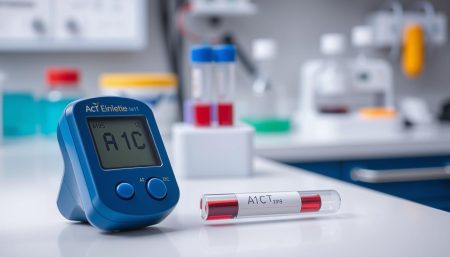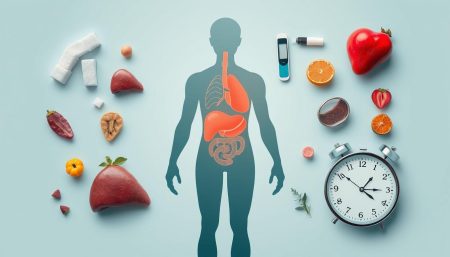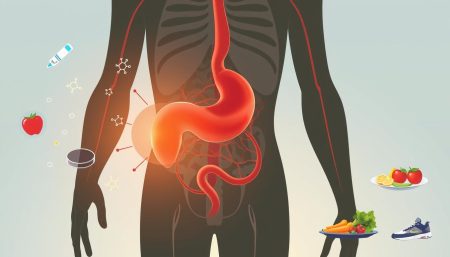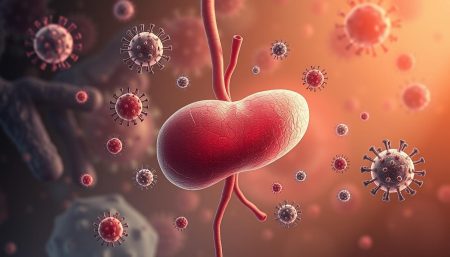Diabetes mellitus and ketoacidosis together create a serious health issue. It shows how important quick care and the right management are. Diabetes mellitus with ketoacidosis is risky, but knowing how to handle diabetic emergencies can make a big difference.
Quick and effective care for this crisis needs deep knowledge. This includes insulin therapy for DKA, which is key to stopping dangerous health processes. We give patients and healthcare teams the tools and knowledge to face this serious condition confidently.
We will explore diabetic ketoacidosis, its symptoms, treatments, and prevention in detail. This education aims to empower everyone. Proactive management of diabetes is key to staying healthy and full of life.
Understanding Diabetes Mellitus with Ketoacidosis
Diabetic ketoacidosis (DKA) is a serious problem for people with diabetes, mostly type 1. This part will explain what DKA is, how it happens, and what can cause it.
Diabetic Ketoacidosis Definition
DKA is a serious diabetes problem. It happens when the body makes too many blood acids called ketones. This is because there’s not enough insulin, so the body uses fat too quickly. This leads to ketones building up in the blood.
The Pathophysiology of DKA
DKA happens because of a lack of insulin and more of other hormones. These hormones make blood sugar and ketones go up. Without enough insulin, glucose can’t get into cells, so the liver makes more glucose. This makes blood sugar levels even higher. At the same time, fatty acids turn into ketones, causing acidosis.
Triggers of Ketoacidosis in Diabetes Patients
- Infections, which can increase hormone levels that work against insulin
- Missed insulin doses, a common mistake, which can quickly alter metabolic balance
- Physical or emotional stress, capable of disrupting hormone levels and glycemic control
- Certain medications that impair insulin effectiveness or promote glucose production
Knowing about these causes is key to managing and maybe stopping DKA. Understanding how DKA starts can help doctors and patients avoid its dangers.
Recognizing the Symptoms of Diabetic Ketoacidosis
Diabetic ketoacidosis (DKA) is a serious condition that can happen to people with diabetes. It occurs when the body lacks insulin, leading to high blood sugar and ketones. Spotting DKA symptoms early is key to getting the right treatment and avoiding ketoacidosis complications.
Here are some common signs of diabetic ketoacidosis:
- Excessive thirst
- Frequent urination
- Nausea and vomiting
- Abdominal pain
- Weakness or fatigue
- Shortness of breath
- Fruity-scented breath
- Confusion or difficulty concentrating
Severe DKA symptoms include extreme dehydration. This can cause dizziness and fainting. It’s vital to catch these signs early and see a doctor right away. This helps manage the condition and avoid ketoacidosis complications.
| Symptom | Description | Commonality |
|---|---|---|
| Excessive thirst | Unusually strong urge to drink water | Very Common |
| Frequent urination | Increased need to urinate, often in large amounts | Very Common |
| Nausea and vomiting | Feeling sick to the stomach, which can lead to vomiting | Common |
| Abdominal pain | Pain or discomfort located between the chest and pelvic regions | Common |
To manage and spot DKA symptoms well, regular monitoring and doctor visits are important. This is true for those at risk of ketoacidosis complications. Getting medical help early can greatly improve treatment outcomes.
Hyperglycemia Treatment Guidelines
Effective hyperglycemia treatment is key in managing diabetic ketoacidosis (DKA). It involves fluid and electrolyte management, insulin therapy, and careful glucose monitoring in diabetic ketoacidosis. This guide is based on clinical studies and recommendations from top diabetes associations.
When DKA is diagnosed, the first step is to stabilize the patient. This includes correcting hyperglycemia and restoring electrolyte balance. Quick action is vital to avoid complications and ensure good results.
- Fluid Replacement: To counteract dehydration and restore blood volume.
- Insulin Administration: To reduce blood glucose levels and halt ketone production.
- Monitoring: Continuous glucose monitoring in diabetic ketoacidosis to guide treatment decisions.
Once DKA is under control, the treatment shifts to adjusting insulin and electrolytes. This requires careful glucose monitoring to customize the treatment plan.
| Treatment Phase | Action | Purpose |
|---|---|---|
| Initial Stabilization | Fluid infusion, insulin therapy | Restore hydration, lower glucose levels |
| Ongoing Management | Adjust insulin dosage | Maintain optimal blood glucose levels |
| Monitoring | Regular blood glucose checks | Fine-tune treatments based on patient response |
The guidelines aim to improve hyperglycemia treatment outcomes in DKA. They combine evidence-based practices with timely interventions. Healthcare professionals can greatly reduce the risks of hyperglycemia and DKA by managing these factors well.
Insulin Therapy for DKA
In managing diabetic emergencies like diabetic ketoacidosis (DKA), insulin therapy is key. It’s important for lowering blood sugar and stopping ketosis’s harmful effects. We’ll look at how insulin works in treatment, focusing on the critical steps for managing the disease.
The Role of Insulin in Treating Ketoacidosis
Insulin therapy for DKA starts with quick insulin shots to lower high glucose levels. This stops fat breakdown and ketone production, improving blood acidity.
Protocols for Insulin Administration
First, insulin is given through an IV to quickly lower blood sugar. Once sugar levels are good, shots are used to keep them stable. This careful approach avoids too-low blood sugar and other risks.
Adjusting Insulin Doses in Response to Blood Sugar Levels
Insulin doses must change based on blood sugar levels. Regular checks let doctors adjust insulin to meet the patient’s needs, adapting to changes in sugar levels.
Knowing the details of insulin therapy and how to adjust it is key to treating DKA. Here’s a quick overview:
| Phase | Insulin Administration | Glucose Monitoring Frequency |
|---|---|---|
| Initial Phase | IV insulin until glucose < 250 mg/dL | Every hour |
| Transition Phase | Subcutaneous insulin | Every 2-4 hours |
| Maintenance Phase | Adjusted subcutaneous dose | Every 4-6 hours |
Managing DKA emergencies needs a solid plan for insulin therapy. This plan is based on careful glucose monitoring. It helps manage the crisis and prevents future ones.
Glucose Monitoring in Diabetic Ketoacidosis
Managing diabetic ketoacidosis (DKA) well depends on careful glucose monitoring in diabetic ketoacidosis. It’s key for quick action and preventing DKA recurrence. Continuous glucose monitoring (CGM) systems give real-time data. This helps keep blood sugar in check and stops future episodes.
CGM lets doctors adjust insulin quickly and right. Here’s how tech helps manage DKA well:
- Real-time glucose trends help adjust insulin therapy.
- Alerts for glucose spikes and drops are key to avoiding DKA complications.
- Data analytics predict glucose changes, helping manage DKA proactively.
Even though it’s not as constant, regular glucose checks are important. They give quick looks at blood sugar levels. This is key during recovery, helping shape long-term plans to prevent DKA recurrence.
| Monitoring Type | Frequency | Utilization | Benefits |
|---|---|---|---|
| Continuous Glucose Monitoring | 24/7 | Acute DKA management | Real-time data, immediate adjustments |
| Periodic Glucose Monitoring | Several times a day | Post-acute phase | Scheduled checks, long-term trends |
Using both types of glucose monitoring covers all stages, from crisis to recovery and prevention. This method quickly stabilizes patients. It also builds a plan for long-term health and avoiding future DKA.
Risks Associated with Diabetic Ketoacidosis
Diabetic ketoacidosis (DKA) is a serious condition that can cause severe health problems. It’s important to understand and manage diabetic emergencies to avoid these risks. This section will look at both short-term and long-term effects of DKA.
Short-term Complications
When DKA starts, patients face serious issues that need quick medical help. These include severe dehydration, imbalances in electrolytes, and brain swelling. These problems can be deadly if not treated right away. It’s key to act fast and correctly to manage these emergencies.
Long-term Implications for Diabetic Patients
Recurring DKA episodes can have long-lasting effects on a patient’s health and life quality. These can include kidney damage and a higher risk of heart disease. It’s important to keep a close eye on blood sugar levels to prevent these serious problems.
- Hydration: Drinking enough water helps prevent kidney failure and keeps the heart healthy.
- Electrolyte Management: Keeping an eye on and adjusting electrolytes is key to avoid heart rhythm problems.
- Regular Health Monitoring: Regular doctor visits can help catch and manage the chronic effects of DKA, leading to better long-term health.
By being proactive and careful, we can reduce the risks of ketoacidosis complications. This helps protect the health of people with diabetes.
In-depth Look at Ketoacidosis Complications
It’s important to understand ketoacidosis complications and how insulin therapy for DKA helps. This knowledge is key for managing diabetes well. By looking at the specific problems, we can plan better to prevent and treat them early.
Ketoacidosis complications can be serious, even life-threatening. Right away, they can cause dehydration and imbalances in electrolytes. Insulin therapy can help fix these issues. But, without quick and right treatment, things can get worse.
- Electrolyte Imbalance: This means potassium, sodium, and chloride levels are off. It can harm the heart and muscles.
- Swelling in the Brain: Called cerebral edema, it’s a big risk, mainly for kids and teens.
- Kidney Failure: High blood sugar and dehydration can damage or fail the kidneys.
Starting insulin therapy for DKA early and watching it closely is key. It helps keep blood sugar and electrolytes in check. This lowers the chance of kidney failure and other serious problems.
Staying alert and using insulin therapy carefully can really help. It can make a big difference in a patient’s life and health.
Managing Diabetic Emergencies: Essential Steps
When you face a diabetic emergency, quick action is key. A structured approach to manage symptoms of diabetic ketoacidosis (DKA) is vital. Using insulin therapy for DKA is a critical step in these urgent situations.
DKA Symptoms Checklist
- Excessive thirst and frequent urination
- High blood glucose levels
- Ketones in the urine
- Rapid breathing
- Fatigue and weakness
- Nausea and vomiting
- Abdominal pain
- Confusion or a difficulty in concentrating
Emergency Interventions for Diabetic Ketoacidosis
Quick medical help is essential for diabetic emergencies, like DKA symptoms. Key steps include:
- Starting insulin therapy for DKA quickly to control blood sugar.
- Keeping fluids and electrolytes balanced to fight dehydration and acidosis.
- Checking vital signs and glucose levels often to adjust treatment as needed.
Accessing Medical Care in a Timely Fashion
Managing diabetic emergencies well means knowing when to get medical help. Getting care fast is key to better outcomes for DKA.

| Emergency Measure | Objective | Expected Outcome |
|---|---|---|
| Administering Insulin | Lower blood glucose levels | Prevent hyperglycemia-related complications |
| Fluid Replacement | Rehydrate and restore electrolyte balance | Enhance physiological stability |
| Continuous Monitoring | Track and adjust treatment efficacy | Timely intervention adjustments |
Lifestyle Modifications and Preventing DKA Recurrence
Changing your lifestyle is key to preventing DKA recurrence. Focus on nutritional considerations in managing diabetes. A balanced lifestyle helps control blood sugar and lowers the risk of serious diabetes problems.
- Dietary Adjustments: Eating a diet friendly for diabetes can greatly lower DKA risk. It should be rich in nutrients, low in simple sugars, and high in fiber.
- Regular Physical Activity: Doing moderate exercise for 150 minutes a week helps control blood sugar and improves health.
- Stress Management: Stress can cause blood sugar spikes and DKA. Using mindfulness, yoga, and therapy can help manage stress.
Studies on diabetes lifestyle interventions show great results. People who followed the recommended lifestyle changes had fewer DKA episodes.
| Lifestyle Factor | Impact on Diabetes Control | Impact on DKA Risk |
|---|---|---|
| Diet Rich in Complex Carbohydrates | Improves Long-term Blood Glucose Levels | Decreases DKA Episodes |
| Consistent Exercise Routine | Enhances Insulin Sensitivity | Lowers Emergency Hospital Visits |
| Effective Stress Reduction | Stabilizes Blood Sugar Variations | Reduces Acute Diabetic Complications |
By following these nutritional considerations in managing diabetes, you can improve your life quality. It also strengthens your body against DKA. Regular health checks and personalized adjustments are important for staying healthy.
The Importance of Patient Education and Resources
Managing diabetes mellitus with ketoacidosis well depends on good patient education and using the right resources. Knowing about this condition helps patients make better health choices and follow diabetes management plans. This part talks about how education and support help patients understand and handle their condition better.
Understanding Diabetes and Self-Care Measures
Learning about diabetes mellitus with ketoacidosis is key for patients. It helps them spot symptoms early and see how serious it is. A patient who knows a lot about their condition is more likely to stick to their treatment and catch any problems early.
They need to know how to check their blood sugar, what risks to watch out for, and how to use insulin right.
Support Systems and Diabetes Management Programs
Support systems are vital for keeping patients involved in managing their diabetes long-term. Programs that offer ongoing education and support from doctors can really help. They make dealing with diabetes easier on both the body and mind.
- Emergency contact lists for quick response during a crisis
- Regular educational workshops that detail nutrition planning and lifestyle changes
- Access to counseling services to address the psychological impact of living with diabetes
| Resource | Description | Benefit |
|---|---|---|
| Personalized Health Plans | Tailored plans that cater to individual health metrics and lifestyle. | Improves adherence to diabetic care and personalizes patient education. |
| Online Tracking Tools | Digital platforms for monitoring blood sugar levels and dietary intake. | Provides real-time data to help with immediate adjustments. |
| Community Support Groups | Forums and meetings with others who are managing diabetes. | Enhances motivation through peer support and shared experiences. |
Nutritional Considerations in Managing Diabetes
Managing diabetes well depends a lot on nutritional considerations in managing diabetes. This is key to keeping blood sugar levels in check and preventing DKA recurrence. Eating a balanced diet full of nutrients helps your health and controls blood sugar. Getting advice from nutritionists who know about diabetes can really help with daily care.
Changing your diet means planning what you eat carefully. You should focus on complex carbs like whole grains and veggies. Avoid simple sugars to prevent blood sugar spikes. Here’s how diet affects managing and preventing diabetes:
| Dietary Component | Benefits | Recommendations |
|---|---|---|
| Carbohydrates | Provide energy, influence insulin response | Choose whole grains, fiber-rich vegetables |
| Proteins | Supports tissue repair and growth | Lean meats, plant-based proteins like beans |
| Fats | Necessary for hormonal functions | Prefer unsaturated fats from fish, nuts, and avocados |
| Hydration | Helps manage blood glucose levels | Adequate daily intake of water |
It’s also important to think about micronutrients and herbal supplements. They help with enzyme functions and metabolism. But, people with diabetes should talk to their doctors before adding them to their diet. Getting a diet plan from a professional can improve health and help with managing complications like hair loss linked to bad blood sugar control.
For better nutrition and to prevent DKA recurrence, see a dietitian who knows about diabetes. They can give you personalized advice based on the latest nutrition science.
- Regular meal planning to stabilize blood sugar.
- Monitoring carbohydrate intake to avoid hyperglycemia.
- Incorporating physical activity to improve insulin sensitivity.
Nutrition is key to managing diabetes well and preventing complications. With the right diet, you can manage the disease better and live a healthy life.
Mental Health and Diabetic Ketoacidosis
Diabetic ketoacidosis (DKA) treatment goes beyond just medicine. It also needs to address the patient’s mental health. The emotional impact of diabetes in emergencies is huge. So, it’s key to have good mental health support plans.

The Emotional Impact of a Diabetic Emergency
DKA can cause a lot of emotional pain. Patients might feel scared, anxious, and unsure of themselves. If these feelings aren’t handled, it can slow down recovery and make managing diabetes harder. It’s vital for doctors to know how diabetes affects emotions. This way, they can create a supportive space for better care.
Mental Health Support for Chronic Illness Management
Getting ongoing mental health support is essential for people with diabetes. A care plan that includes therapy, support groups, and ways to handle stress can really help. Healthcare teams should make sure to include mental health in the overall treatment plan. This ensures a complete approach to managing diabetes.
A Case for Regular Health Checks and DKA Risk Assessment
The importance of regular health checks and DKA risk assessment is huge, mainly for those with diabetes. These checks help prevent conditions from getting worse and keep overall health good. For diabetes, these assessments are key to spotting and handling diabetic ketoacidosis (DKA) early.
Glucose monitoring in diabetic ketoacidosis is vital to stop diabetes emergencies. It catches signs of DKA early, allowing for quick action. Doctors use these tests and risk assessments to create care plans just for each patient. This approach, backed by research, helps patients manage their health better.
Thanks to medical progress, we can catch and manage chronic diseases early. This supports the need for regular health screenings. They help spot diabetes problems and other issues like kidney cancer early. This shows that regular health checks are a key to living longer and better.
FAQ
Q: What is diabetes mellitus with ketoacidosis?
A: Diabetes mellitus with ketoacidosis, also known as diabetic ketoacidosis (DKA), is a serious problem. It happens when your body makes too many blood acids called ketones. This is because your body can’t make enough insulin. It’s important to know the risks and manage emergencies with insulin therapy for DKA.
Q: How does diabetic ketoacidosis (DKA) develop?
A: DKA starts when your body doesn’t make enough insulin. This leads to high blood sugar and the body breaking down fat for energy. This makes ketones, making your blood too acidic, which is dangerous if not treated quickly.
Q: What triggers ketoacidosis in people with diabetes?
A: Things like infections, missing insulin doses, stress, and other issues can trigger ketoacidosis. Knowing and managing these triggers can help stop DKA from happening.
Q: What are typical symptoms of diabetic ketoacidosis (DKA)?
A: Symptoms of DKA come on fast. They include being very thirsty, needing to pee a lot, feeling sick, weak, confused, and sometimes losing consciousness. Spotting these signs early is key to getting the right treatment and avoiding serious problems.
Q: What are the recommended treatments for hyperglycemia in cases of DKA?
A: Treating high blood sugar in DKA involves giving fluids to fight dehydration, replacing lost minerals, and using insulin to lower blood sugar and stop ketones. This helps reverse the acid problem.
Q: What role does insulin play in treating ketoacidosis?
A: Insulin is key in treating DKA. It lowers blood sugar and reduces ketones, helping to fix the acid problem. Doctors adjust insulin doses based on blood sugar levels to keep them safe.
Q: How can glucose monitoring prevent the recurrence of DKA?
A: Keeping an eye on blood sugar levels with glucose monitoring helps manage blood sugar better. It catches changes that might mean treatment needs to be adjusted. This is important for managing DKA and preventing it from coming back.
Q: What are the short-term and long-term risks associated with diabetic ketoacidosis?
A: DKA can cause dehydration, imbalance of minerals, and brain swelling in the short term. Long-term, it can harm organs like the kidneys and heart, and make it harder to control blood sugar.
Q: How are diabetic emergencies like DKA managed?
A: Handling diabetic emergencies like DKA means spotting symptoms fast, acting quickly, and getting medical help fast. This includes giving fluids and insulin, and getting to a hospital for the best care.
Q: What lifestyle modifications help prevent DKA recurrence?
A: To prevent DKA from coming back, making healthy food choices, staying active, following your diabetes treatment plan, and checking blood sugar regularly are key. These steps help manage diabetes long-term.
Q: Why is patient education important in managing diabetes mellitus with ketoacidosis?
A: Teaching patients about diabetes is vital. It helps them take care of themselves, use support systems, and prevent complications. This proactive approach is important for managing diabetes well.
Q: How do nutritional considerations play a role in managing diabetes?
A: What you eat is very important in managing diabetes. The right diet can help control blood sugar, keep weight in check, and lower DKA risk. Dietitians can give personalized advice on balancing carbs, fats, and proteins.
Q: What is the impact of mental health on managing diabetic ketoacidosis?
A: Dealing with a diabetic emergency can be very stressful, leading to anxiety or depression. It’s important to have mental health support to help manage chronic illness. This support helps patients cope and stick to their treatment plans.
Q: Why are regular health checks and DKA risk assessments important?
A: Regular health checks and DKA risk assessments can catch rising blood sugar levels early. This helps prevent ketoacidosis. These checks are a way to catch and fix problems before they turn into emergencies.


















